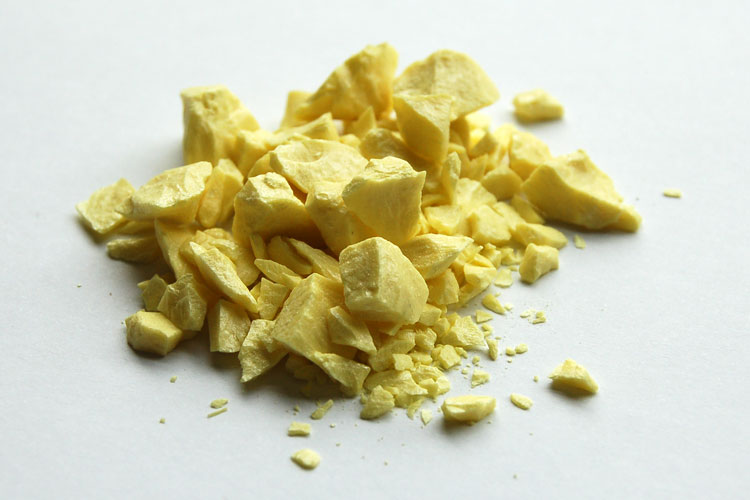Sulfur is a chemical element that is non-metallic. It has a pale yellow color and has no odor. Sulfur in gaseous form combines with oxygen to form sulfur oxide. Sulfur is used to make fertilizer and various types of disinfectant. It is also used in medical laboratories to test skin disease. Sulfur is, however, a hazardous element that should be handled with care.
Sulfur in a gaseous state mixes with oxygen to form sulfur dioxide, which is hazardous. Inhalation of sulfur fumes causes irritation of the eyes, nose and respiratory track, which leads to headaches, dizziness and nausea. High levels of sulfur can burn the skin, and it can also cause pulmonary edema, a condition in which the lungs are filled up with fluids. Inhaling sulfur may also cause coughing, sneezing or labored breathing.
When sulfur dust comes into contact with oxygen to become sulfur dioxide, it has serious environmental hazards. It affects the living organisms around the area. Sulfur causes vascular damage in veins of the brain, the heart and the kidney. Sulfur can also cause damage to the internal enzyme systems of animals.
Sulfur is Combustible and is an Explosion Hazard:
When most people think of controlling dust in the workplace, they think of taking steps to avoid inhaling dusts to prevent health problems. However, the accumulation of combustible dusts in the workplace can lead to far greater consequences. As seen in recent years, neglect of housekeeping and improper handling of combustible dusts can lead to property damage, injuries and loss of life.
Fine dust of sulfur dispersed in the air is a potential hazard. When sulfur dust mixes with oxygen, it forms sulfur dioxide, which when ignited causes explosion. Dust suspended in air is readily ignited by fumes or static electricity and can cause destructive fires. Fires caused by sulfur are hard to put out because once they spread the presence of oxygen only serves to increase the fire.
Sulphur is a flammable substance in both the solid and liquid states. The dust is characterised by a very low ignition point of 190°C compared to other combustible dusts, and dust clouds are readily ignited by weak frictional sparks. Dusts containing 25% or more elemental sulphur may be almost as explosive as pure sulphur.
The National Fire Protection Association (NFPA) defines a combustible dust as “a combustible particulate solid that presents a fire or deflagration hazard when suspended in air or some other oxidizing medium over a range of concentrations, regardless of particle size or shape.”
In general, combustible particulates having an effective diameter of 420 μm or smaller, as determined by passing through a U.S. No. 40 Standard Sieve, are generally considered to be combustible dusts. However, agglomerates of combustible materials that have lengths that are large compared to their diameter (and will not usually pass through a 420 μm sieve) can still pose a deflagration hazard. Therefore, any particle that has a surface area to volume ratio greater than that of a 420 μm diameter sphere should also be considered a combustible dust. The vast majority of natural and synthetic organic materials, as well as some metals, can form combustible dust. The NFPA’s Industrial Fire Hazards Handbook states, “any industrial process that reduces a combustible material and some normally non-combustible materials to a finely divided state presents a potential for a serious fire or explosion.”
Suggested Industrial Vacuums for Recovery of Toxic & Combustible Dust
PrestiVac HEPAPlus* Vacuums are specifically designed to safely vacuum toxic dusts. Equipped with a Certified Absolute HEPAPlus*filter with an efficiency of 99.995% on 0.2 micron so there is no risk of exposure or contamination for the operator or the environment. These vacuums are tested for absolute filtration. Testing Method: IEST RP-CC034.3. H14. MIL-STD 282 / A.S.T.M. - D2986-91. MPPS method EN 1822.
PrestiVac Explosion Proof/Dust Ignition Protected Vacuums are designed to safely vacuum explosive, flammable, combustible conductive* dusts. Our Explosion Proof/Dust Ignition Protected Vacuums are completely grounded and static dissipating because they are built entirely with non-sparking metals and do not have any painted components so there is no risk of fire or explosion from a spark or static build up. All the electrical components, including the motor and starter are totally enclosed so there is no source of ignition. Our explosion proof vacuum cleaners comply with NFPA 484 guidelines and are an effective tool for good housekeeping practise as per OSHA.
Which Industries are at Risk with Sulfur?













